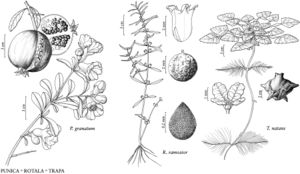Rotala ramosior
Fl. Bras. 13(2): 194. 1877.
Herbs annual, terrestrial or amphibious. Stems erect, unbranched or branched. Leaves opposite, monomorphic; blade oblongelliptic to oblanceolate, 10–50 × 2–12 mm, base attenuate, margins membranous. Inflorescences solitary flowers in axils of main-stems. Floral-tube 2–4 × 1–2 mm; epicalyx segments shorter to longer than sepals; sepals margins membranous; petals caducous, often 0, sometimes 4, white or pink, obovate, scarcely surpassing length of sepals; stamens inserted near base of floral-tube; style slender; stigma capitate. Capsules 2–4.5 × 2–4.5 mm, (3 or) 4-valved. 2n = 16 (Mexico), 32.
Phenology: Flowering summer–fall.
Habitat: Low wet areas, marshes, temporary pools, rice fields, ditches.
Elevation: 0–1900 m.
Distribution
B.C., Ont., Ala., Ariz., Ark., Calif., Colo., Conn., Del., D.C., Fla., Ga., Idaho, Ill., Ind., Iowa, Kans., Ky., La., Md., Mass., Mich., Minn., Miss., Mo., Mont., Nebr., N.H., N.J., N.Mex., N.Y., N.C., Ohio, Okla., Oreg., Pa., R.I., S.C., S.Dak., Tenn., Tex., Va., Wash., W.Va., Wis., Mexico, West Indies, Central America, South America, in Europe (Italy), Pacific Islands (Philippines)
Discussion
Plants growing in the interior of the continent on rich soil are on average taller with wider leaves, longer bracteoles, and larger capsules than those growing on the sandy coastal plain. They were the basis for var. interior. Plants in the United States with relatively short bracteoles are apparently all diploids (2n = 16). Plants with relatively long bracteoles and longer epicalyx segments, sometimes recognized as var. dentifera, occur in Mexico and southward; they are tetraploids (2n = 32). The extensive distribution in the western United States is due to spread with rice cultivation and with the movement of cattle.
Selected References
None.
